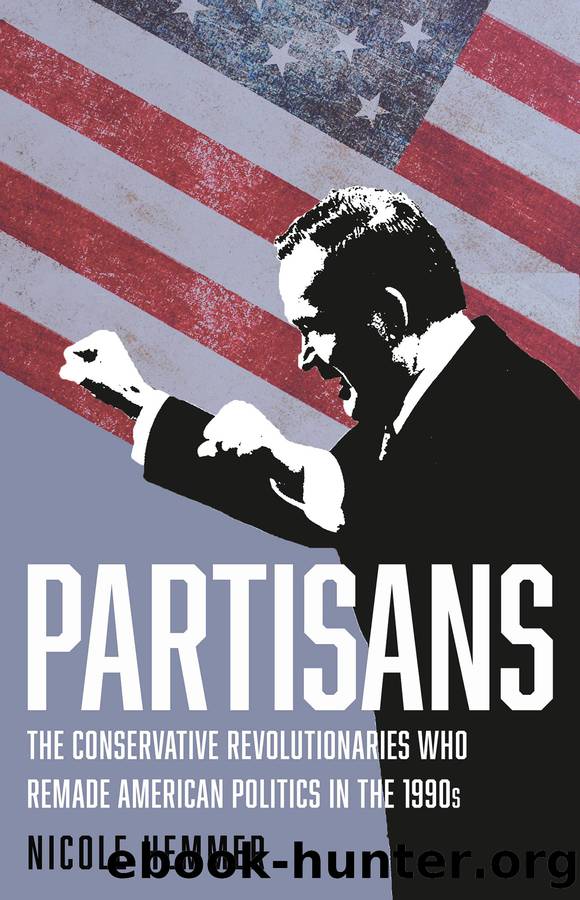Partisans by Nicole Hemmer

Author:Nicole Hemmer [Hemmer, Nicole]
Language: eng
Format: epub
Publisher: Basic Books
Published: 2022-08-30T00:00:00+00:00
If hard-line, race-based immigration restrictions were a deviation from the Reagan era, an opposition to Great Society civil rights and poverty programs, particularly those aimed at helping Black Americans, seemed very much like a continuation of it. But the new writing on Black Americans, inequality, and government intervention deviated sharply from Reaganâs libertarian-minded approach. Reagan asserted these programs failed because they were a matter of government overreach, interrupting the natural state of the market and social relations. He offered an optimistic (even Pollyannaish) view of what would exist without government interference: a colorblind, meritocratic, and equality-based society.
Writers like Charles Murray, Richard Herrnstein, and Dinesh DâSouza painted a much bleaker picture. When they looked at Black inequalityâin wealth, in educational attainment, in life expectancy, in political powerâthey saw the root cause not as racism or ineffective government intervention but as problems that existed within the Black communityâin Murray and Herrnsteinâs case, an intelligence deficit; in DâSouzaâs, a cultural one. Those arguments would not only lay the groundwork for a more pessimistic, color-conscious racism on the right but also provide a more respectable version of anti-Black politics than that of someone like David Duke (who, for all his efforts to appear respectable, could never truly disassociate himself from the Klan).
Murray and Herrnsteinâs The Bell Curve became an instant sensation when it hit shelves in 1994. In it, they offered a number of arguments about IQ, societal problems, and race. The core contentions were that IQ was, to a significant degree, heritable and unchangeable; that low IQ correlated to both race and negative social behaviors, leading to poverty, crime, and out-of-wedlock children; and that policy should take those correlations into account. Though crammed full of charts and equations, The Bell Curve was not a scientific tractâthe authors were a political scientist (Murray) and a psychologist (Herrnstein), not scientists or geneticists. It was instead a policy book that used poorly interpreted and dubiously sourced pseudoscientific data to build its arguments.15
The Bell Curve was a broadside against the Great Society and a call for new policies that, while not explicitly race based, would have profound consequences for Black people and nonwhite immigrants. The authors called for, among other things, elimination of aid to poor mothers so they would stop having children; an end to the use of affirmative action in college admissions, which they argued raised low-IQ people of color above their ability levels; and a shift in immigration law from family-based immigration to merit-based immigration in order to favor higher-IQ immigrants.
These were not new ideas, of course. Scientific racism had been around for centuries, confidently asserting schema for racial classifications and racial superiority. Herrnstein himself had been on the race-IQ beat for almost a quarter century, part of a renaissance of scientific racism repackaged around contemporary intelligence research. In a 1971 piece for The Atlantic, he argued government spending on education and antipoverty programs could not promote equality, because they did not address racial groupsâ inherited differences in IQ. The article proved as influential as it was controversial.
Download
This site does not store any files on its server. We only index and link to content provided by other sites. Please contact the content providers to delete copyright contents if any and email us, we'll remove relevant links or contents immediately.
| Anarchism | Communism & Socialism |
| Conservatism & Liberalism | Democracy |
| Fascism | Libertarianism |
| Nationalism | Radicalism |
| Utopian |
The Secret History by Donna Tartt(16643)
The Social Justice Warrior Handbook by Lisa De Pasquale(11492)
Thirteen Reasons Why by Jay Asher(7796)
This Is How You Lose Her by Junot Diaz(5790)
Weapons of Math Destruction by Cathy O'Neil(5045)
Zero to One by Peter Thiel(4832)
The Myth of the Strong Leader by Archie Brown(4795)
Promise Me, Dad by Joe Biden(4452)
Beartown by Fredrik Backman(4427)
Stone's Rules by Roger Stone(4420)
How Democracies Die by Steven Levitsky & Daniel Ziblatt(4407)
The Fire Next Time by James Baldwin(4348)
100 Deadly Skills by Clint Emerson(4084)
A Higher Loyalty: Truth, Lies, and Leadership by James Comey(4038)
Rise and Kill First by Ronen Bergman(4016)
The David Icke Guide to the Global Conspiracy (and how to end it) by David Icke(3889)
The Farm by Tom Rob Smith(3878)
Secrecy World by Jake Bernstein(3787)
The Doomsday Machine by Daniel Ellsberg(3736)
